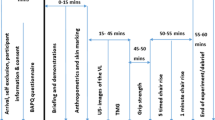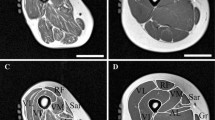Abstract
Background and aims: Gastrocnemius and soleus in the triceps surae have functional and histological differences. We therefore investigated age-related changes in muscle thickness of these two muscles, as well as the difference in these changes between men and women. Methods: Participants comprised 847 healthy adults aged 20 to 79 years. A B-mode ultrasound scanner, with participants sitting on a chair, was used to measure muscle thickness from the midpoint of the gastrocnemius medialis muscle at the level of maximum girth (target point). The ratio of muscle thickness to height was calculated. The inter-rater and intra-rater reliability of measuring muscle thickness with the ultrasound scanner and the validity of the target point were demonstrated before the examination. Results: Gastrocnemius was significantly thinner in women aged 60 or older and in men aged 50 or older, compared with their counterparts in their 20s. For soleus, no significant differences in thickness were found among the age groups in either sex. Decline in muscle thickness from age 40–79 was greater for gastrocnemius than for soleus. Conclusions: These results confirm that gastrocnemius starts to deteriorate earlier and atrophies at a faster pace than soleus. A significant sex difference was found only in the onset age of gastrocnemius deterioration, which was earlier in men than in women.
Similar content being viewed by others
References
Okada M. An electromyographic estimation of the relative muscular load in different human postures. J Hum Ergol 1973; 1: 75–93.
Inman VT, Ralston HJ, Todd F. Human Walking. Baltimore: Williams & Wilkins, 1981.
Fujiwara K, Ikegami H, Okada M, Koyama Y. Contribution of age and muscle strength of lower limbs to steadiness and stability in standing posture (in Japanese, with English abstract). J Anthropol Soc Nippon 1982; 90: 385–400.
Nadeau S, Gravel D, Arsenault AB, Bourbonnais D. Plantarflexor weakness as a limiting factor of gait speed in stroke subjects and the compensating role of hip flexors. Clin Biomech (Bristol, Avon) 1999; 14: 125–35.
Gurfinkel VS, Lipshits MI, Mori S, Popov KE. Postural reactions to the controlled sinusoidal displacement of the supporting platform. Agressologie 1976; 17: 71–6.
Woollacott MH, Bonnet M, Yabe K. Preparatory process for anticipatory postural adjustments: modulation of leg muscles reflex pathways during preparation for arm movements in standing man. Exp Brain Res 1984; 55: 263–71.
Johnson MA, Polgar J, Weightman D, Appleton D. Data on the distribution of fibre types in thirty-six human muscles. An autopsy study. J Neurol Sci 1973; 18: 111–29.
Trappe SW, Trappe TA, Lee GA, Costill DL. Calf muscle strength in humans. Int J Sports Med 2001; 22: 186–91.
Lee WS, Cheung WH, Qin L, Tang N, Leung KS. Age-associated decrease of type IIA/B human skeletal muscle fibers. Clin Orthop Relat Res 2006; 450: 231–7.
Lexell J. Human aging, muscle mass, and fiber type composition. J Gerontol A Biol Sci Med Sci 1995; 50: 11–6.
Miller AE, MacDougall JD, Tarnopolsky MA, Sale DG. Gender differences in strength and muscle fiber characteristics. Eur J Appl Physiol Occup Physiol 1993; 66: 254–62.
Adolphson P, von Sivers K, Jonsson U, Dalén N, Dahlborn M. Bone and muscle mass after hip rearthroplasty. Controlled CT study of 12 patients. Acta Orthop Scand 1993; 64: 282–4
Miyatani M, Kanehisa H, Kuno S, Nishijima T, Fukunaga T. Validity of ultrasonograph muscle thickness measurements for estimating muscle volume of knee extensors in humans. Eur J Appl Physiol 2002; 86: 203–8.
Bandholm T, Sonne-Holm S, Thomsen C, Bencke J, Pedersen SA, Jensen BR. Calf muscle volume estimates: implications for botulinum toxin treatment? Pediatr Neurol 2007; 37: 263–9.
Chow RS, Medri MK, Martin DC, Leekam RN, Agur AM, McKee NH. Sonographic studies of human soleus and gastrocnemius muscle architecture: gender variability. Eur J Appl Physiol 2000; 82: 236–44.
Narici M, Cerretelli P. Changes in human muscle architecture in disuse-atrophy evaluated by ultrasound imaging. J Gravit Physiol 1998; 51: 73–4.
Isokawa M, Imanaka K, Ootuki F et al. New physical fitness standards of Japanese people (in Japanese). Tokyo: Fumaidoshuppan, 2000: 21–6, 70–7.
Fukunaga T, Roy RR, Shellock FG et al. Physiological cross-sectional area of human leg muscles based on magnetic resonance imaging. J Orthop Res 1992; 10: 928–34.
Sanada K, Kearns CF, Midorikawa T, Abe T. Prediction and validation of total and regional skeletal muscle mass by ultrasound in Japanese adults. Eur J Appl Physiol 2006; 96: 24–31.
Takaishi M. Secular trend in growth. (In Japanese) Japanese Journal of Public Health 1975; 22: 563–9.
Tanner JM. Foetus into Man: Physical Growth from Conception to Maturity. London: Open Books Publishing, 1978.
Narici MV, Hoppeler H, Kayser B et al. Human quadriceps cross-sectional area, torque and neural activation during 6 months strength training. Acta Physiol Scand 1996; 157: 175–86.
Henneman E, Somjen G, Carpenter DO. Excitability and inhibitability of motoneurons of different size. J Neurophysiol 1965; 28: 599–620.
Walmsley B, Hodgson JA, Burke RE. Forces produced by medial gastrocnemius and soleus muscles during locomotion in freely moving cats. J Neurophysiol 1978; 41: 1203–16.
Morse CI, Thom JM, Davis MG, Fox KR, Birch KM, Narici MV. Reduced plantarflexor specific torque in the elderly is associated with a lower activation capacity. Eur J Appl Physiol 2004; 92: 219–26.
Davis MG, Fox KR. Physical activity patterns assessed by accelerometry in older people. Eur J Appl Physiol 2007; 100: 581–9.
Lamberts SWJ, van den Beld AW, van der Lely AJ. The endocrinology of aging. Science 1997; 278: 419–24.
Tooze JA, Schoeller DA, Subar AF, Kipnis V, Schatzkin A, Troiano RP. Total daily energy expenditure among middle-aged men and women: the OPEN Study. Am J Clin Nutr 2007; 86: 382–7.
Sipilä S, Poutamo J. Muscle performance, sex hormones and training in peri-menopausal and post-menopausal women. Scand J Med Sci Sports 2003; 13: 19–25.
Ministry of Health, Labour and Welfare. Abridged life tables for Japan 2006. Tokyo: Health and Welfare Statistics Association, 2006.
Author information
Authors and Affiliations
Corresponding author
Rights and permissions
About this article
Cite this article
Fujiwara, K., Asai, H., Toyama, H. et al. Changes in muscle thickness of gastrocnemius and soleus associated with age and sex. Aging Clin Exp Res 22, 24–30 (2010). https://doi.org/10.1007/BF03324811
Received:
Accepted:
Published:
Issue Date:
DOI: https://doi.org/10.1007/BF03324811




